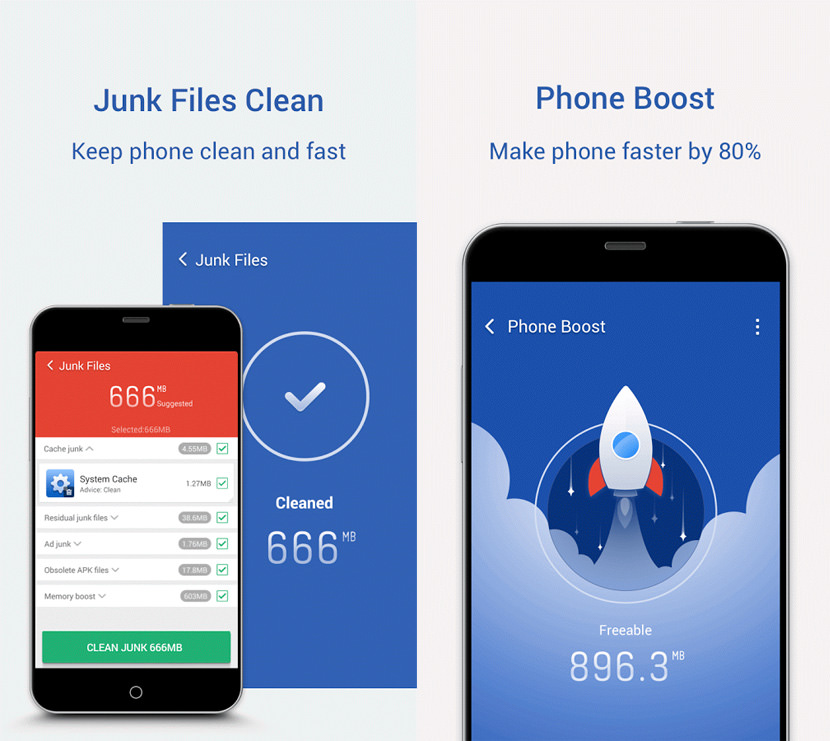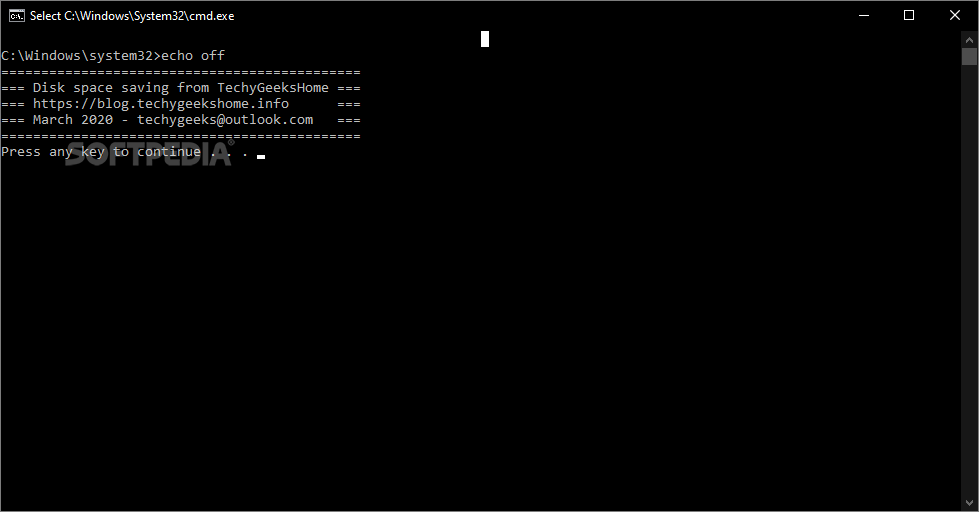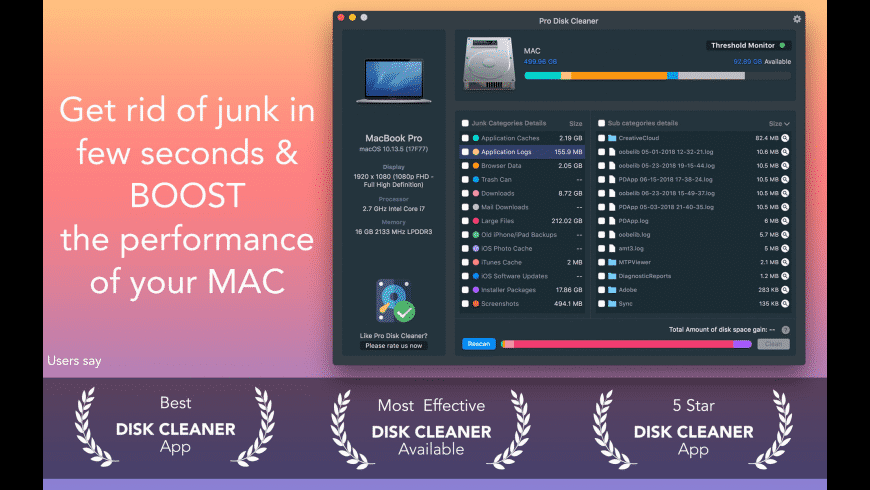| Developer(s) | Microsoft |
|---|---|
| Operating system | Microsoft Windows |
| Type | Disk maintenance application |
| Website | www.microsoft.com |
Smart Disk Cleanup provides a safe and easy way to clean up junk files, duplicates, and large files. In just a few minutes you can safely and easily free up GBs of disk space. Items cleaned with Smart Disk Cleanup: Duplicates - Unnecessary duplicate files can take up GBs of disk space. The phone cleaning app not only does wonders for Android but also for Windows 10 PCs and macOS.You can remove junk, clean your phone’s RAM, and reclaim more space using CCleaner. Click on Apps & features. Use the 'Sort by' filter and select the Size view to identify the apps and games using the most space quickly. Select the item you want to remove. Click the Uninstall button. The description of Space Cleaner App Space Cleaner - Super Cleaner & Booster is a light, fast and professional phone cleaner & booster for android FREE! Space Cleaner can clean your phone and remove junk files easily! The android has become lags and freezes most of the time?
Disk Clean-up (cleanmgr.exe) is a computer maintenance utility included in Microsoft Windows designed to free up disk space on a computer's hard drive. The utility first searches and analyzes the hard drive for files that are no longer of any use, and then removes the unnecessary files. There are a number of different file categories that Disk Clean-up targets when performing the initial disk analysis:
- Compression of old files
- Temporary Internet files
- Temporary Windows files
- Downloaded program files
- Recycle Bin
- Removal of unused applications or optional Windows components
- Setup log files
- Offline web pages (cached)
- WinSxS (Windows component store)
The above list, however, is not exhaustive. For instance, 'Temporary Remote Desktop files' and 'Temporary Sync Files' may appear only under certain computer configurations, differences such as Windows Operating System and use of additional programs such as Remote Desktop. The option of removing hibernation data may not be ideal for some users as this may remove the hibernate option.
Aside from removing unnecessary files, users also have the option of compressing files that have not been accessed over a set period of time. This option provides a systematic compression scheme. Infrequently accessed files are compressed to free up disk space while leaving the frequently used files uncompressed for faster read/write access times. If after file compression, a user wishes to access a compressed file, the access times may be increased and vary from system to system.In addition to the categories that appear on the Disk Clean-up tab, the More Options tab offers additional options for freeing up hard drive space through removal of optional Windows components, installed programs, and all but the most recent System Restore point or Shadow Copy data in some versions of Microsoft Windows.
Starting with Windows 10 version 1803 (RS4), the capabilities of Disk Clean-up are incorporated into Windows 10's Settings app.[1] The standalone Disk Clean-up tool itself is still included.
Microsoft announced that Disk Clean-up utility is Deprecated:
The Disk Cleanup experience (“cleanmgr.exe”) is being deprecated. We’re retaining the Disk Cleanup tool for compatibility reasons. There’s no need to worry since Storage Sense’s functionality is a superset of what the legacy Disk Cleanup provides!
Since Windows 10 version 1809 (RS5), the utility was renamed to 'Disk Clean-up'. It was previously named 'Disk Cleanup'.
See also[edit]
Space Cleanup App For Pc
References[edit]
- ^'Windows 10 Redstone 4 (version 1803): All the new features and changes'.
External links[edit]
These are ways to reduce the amount of storage space used by removing or deleting different types of information from customer engagement apps (Dynamics 365 Sales, Dynamics 365 Customer Service, Dynamics 365 Field Service, Dynamics 365 Marketing, and Dynamics 365 Project Service Automation). Use one or more of these methods to control your total data storage usage. You can delete certain categories of data as the need arises, or you can set up bulk deletion jobs to reoccur at set intervals.
Warning
The suggestions in this topic include deleting notes, attachments, import history, and other data. Before you delete data, be sure that the data is no longer needed because you cannot retrieve deleted data. There is no 'undo' to restore your data once it has been deleted. This means it may make more sense for you to increase the amount of storage space you have with your Microsoft Dynamics 365 subscription instead of reducing the amount of storage space used.
Note
- Except for methods 3 and 5, all these methods require that you have an administrator security role, such as System Administrator. This gives you permission to delete records in bulk and to delete system jobs.
- After performing actions to free up storage, the system can take up to 24 hours to update storage information. We recommend waiting up to 24 hours and monitoring your storage.
- Storage consumed does not directly correspond to the size reported in Microsoft Dataverse for Apps; consumption includes additional storage for metadata and encryption. For example, removing 10MB of storage from a file does not mean the file size is reduced by 10MB.
- Some platform operations require you to wait 24-36 hours to confirm data size changes. Such operations include but are not limited to upgrades to new versions and introduction of new workflows. Such operations require system adjustments that might result in a momentary size increase report.
Freeing storage for Dataverse
Use the following methods to free up storage for each of the capacity types.
| Storage | Method |
|---|---|
| File | |
| Method 3: Remove email attachments using Advanced Find | |
| Method 4: Remove email messages with attachments using a bulk deletion job | |
| Method 5: Remove notes with attachments using Advanced Find | |
| Method 6: Remove notes with attachments using a bulk deletion job | |
| Log | |
| Method 10: Delete audit logs | |
| Delete plug-in trace logs using a bulk deletion job | |
| Database | |
| Method 1: Delete bulk email and workflow instances using a bulk deletion job | |
| Method 2: Evaluate and delete suspended workflows | |
| Method 7: Remove bulk duplicate detection jobs and associated copies of duplicate records | |
| Method 8: Delete bulk import instances using a bulk deletion job | |
| Method 9: Delete bulk deletion job instances using a bulk deletion job | |
| Method 11: Remove unrequired tables and columns from Relevance Search |
Reduce file storage
Method 3: Remove email attachments using Advanced Find
Warning
If you delete this data, the attachments will no longer be available in customer engagement apps. However, if you have them saved in Office Outlook, they will still be there.
Choose Advanced Find ().
In the Look for list, select Email Messages.
In the search criteria area, add criteria similar to the following:
Attachments (Item)
File Size (Bytes) – Is Greater Than - In the text box, type a byte value, such as 1,048,576 (this is binary for 1MB).
Choose Results.
You will now have a list of email messages that have attachments that are larger than 'X' bytes. Review the emails and delete the attachments as needed.
Method 4: Remove email messages with attachments using a bulk deletion job
Warning
If you delete this data, the email messages and their associated attachments will no longer be available in customer engagement apps. However, if you have them saved in Office Outlook, they will still be there.
Go to Settings > Data Management.
Choose Bulk Record Deletion, and then in the menu bar, choose New. This opens the Bulk Deletion Wizard.
Choose Next.
In the Look for list, select Email Messages.
In the search criteria area, add criteria similar to the following:
Status Reason – Equals – Completed
Actual End – Older Than X Months – 1
Attachments (Item)
File Size (Bytes) – Is Greater Than – In the text box, type a byte value, such as 1,048,576 (this is binary for 1MB).
Group the first two criteria rows:
Choose the arrow next to each criteria row, and then choose Select Row.
With both rows selected, choose Group AND.
Choose Next.
In the Name text box, type a name for the bulk deletion job.
Select a date and time for the job start time; preferably a time when users are not in customer engagement apps.
Select the Run this job after every check box, and then in the days list, select the frequency you want the job to run.
If you want a notification e-mail sent, select the Send an email to me (email@domain.com) when this job is finished check box.
- Choose Next, review the bulk deletion job, and then choose Submit to create the recurring job.
Method 5: Remove notes with attachments using Advanced Find
Warning
If you delete this data, notes and their associated attachments will no longer be available in customer engagement apps.
Choose Advanced Find.
In the Look for list, select Notes.
In the search criteria area, add criteria similar to the following:
File Size (Bytes) – Is Greater Than – In the text box, type a byte value, such as 1048576.
Choose Results.
You will now have a list of attachments that are larger than the size you specified.
- Select individual or a multiple attachments, and then choose Delete (X).
Method 6: Remove notes with attachments using a bulk deletion job
Warning
If you delete this data, notes and their associated attachments will no longer be available in customer engagement apps.
Go to Settings > Data Management.
Choose Bulk Record Deletion, and then in the menu bar, choose New. This opens the Bulk Deletion Wizard.
Choose Next.
In the Look for list, select Notes.
In the search criteria area, add criteria similar to the following:
File Size (Bytes) – Is Greater Than – In the text box, type a byte value, such as 1048576.
Created On – Older Than X Months – 1
Group the two criteria rows:
Choose the arrow next to each criteria row, and then choose Select Row.
With all three rows selected, choose Group AND.
Choose Next.
In the Name text box, type a name for the bulk deletion job.
Select a date and time for the job start time; preferably a time when users are not in customer engagement apps.
Select the Run this job after every check box, and then in the days list, select the frequency you want the job to run.
If you want a notification e-mail sent, select the Send an email to me (email@domain.com) when this job is finished check box.
- Choose Next, review the bulk deletion job, and then choose Submit to create the recurring job.
Reduce log storage
Method 10: Delete audit logs
When you enable auditing, customer engagement apps create audit logs to store the audit history of the records. You can delete these audit logs to free space when they are no longer needed.
Disk Space Cleanup
Warning
When you delete an audit log, you can no longer view the audit history for the period covered by that audit log.
Go to Settings > Auditing.
In the Audit area choose Audit Log Management.
Select the oldest audit log, then choose Delete Logs.

- In the confirmation message choose OK.
Note
You can only delete the oldest audit log in the system. To delete more than one audit log repeat deleting the oldest available audit log until you have deleted enough logs.
Reduce database storage

Method 1: Delete bulk email and workflow instances using a bulk deletion job
Warning
If you delete this data, you will no longer be able to tell if an email was sent through bulk email or if a workflow rule ran against a record. The emails that were sent and the actions that ran against the record in the workflow will remain.
Go to Settings > Data Management.
Choose Bulk Record Deletion. In the menu bar, choose New. This opens the Bulk Deletion Wizard.
Choose Next.
In the Look for list, select System Jobs.
In the search criteria area, add criteria similar to the following:
System Job Type – Equals – Bulk E-mail; Workflow;
Status Reason – Equals – Succeeded
Completed On – Older Than X Months – 1
Group the three criteria rows:
Choose the arrow next to each criteria row, and then choose Select Row.
With all three rows selected, choose Group AND.
Choose Next.
In the Name text box, type a name for the bulk deletion job.
Select a date and time for the job start time; preferably a time when users are not in customer engagement apps.
Select the Run this job after every check box, and then in the days list, select the frequency you want the job to run.
If you want a notification e-mail sent, select the Send an e-mail to me (email@domain.com) when this job is finished check box.
- Choose Next, review the bulk deletion job, and then choose Submit to create the recurring job.
Method 2: Evaluate and delete suspended workflows
Sometimes workflows will enter a suspended state because there is a condition that will never be met or some other reason that will not allow the workflow to continue.
Warning
Some workflows will be in a suspended state because they are waiting for a condition that has not yet been met, which is expected. For example, a workflow may be waiting for a task to be completed.
Choose Advanced Find.
In the Look for list, select System Jobs.
In the search criteria area, add criteria similar to the following:
System Job Type – Equals – Workflow
Status Reason – Equals – Waiting
Group the two criteria rows:
Choose the arrow next to each criteria row, and then choose Select Row.
With both rows selected, choose Group AND.
Choose Results.
In the results window, you can open each item to determine whether the workflow can be deleted.
Method 7: Remove bulk duplicate detection jobs and associated copies of duplicate records
Every time that a duplicate detection job runs, a copy of each duplicate record is stored in the database as part of the duplicate detection job. For example, if you have 100 duplicate records, every time that you run a duplicate detection job that finds these duplicates, whether it is manual or reoccurring, those 100 duplicate records will be stored in the database under that instance of that duplicate job until the duplicates are merged or deleted, or until the instance of that duplicate detection job is deleted.

Go to Settings > Data Management.
Choose Duplicate Detection Jobs.
Select the duplicate detection job instances you want to delete and then choose Delete (X).
To avoid wasting storage space, make sure duplicates are resolved promptly so that they are not reported in multiple duplicate detection jobs.
Method 8: Delete bulk import instances using a bulk deletion job
Every time you perform a bulk import, there is a system job associated with that import. The system job details show which records imported successfully and which records failed.
Warning
After you delete these bulk import jobs, you will not be able to see what data was imported and you cannot roll back the import.
Go to Settings > Data Management.
Choose Bulk Record Deletion, and then in the menu bar, choose New. This opens the Bulk Deletion Wizard.
Choose Next.
In the Look for list, select System Jobs.
In the search criteria area, add criteria similar to the following:
System Job Type – Equals – Import
Status Reason – Equals – Succeeded
Completed On – Older Than X Months – 1
Group the three criteria rows:
Choose the arrow next to each criteria row, and then choose Select Row.
With all three rows selected, choose Group AND.
Choose Next.
In the Name text box, type a name for the bulk deletion job.
Select a date and time for the job start time; preferably a time when users are not in customer engagement apps.
Select the Run this job after every check box, and then in the days list, select the frequency you want the job to run.
If you want a notification e-mail sent, select the Send an email to me (email@domain.com) when this job is finished check box.
- Choose Next, review the bulk deletion job, and then choose Submit to create the recurring job.
Method 9: Delete bulk deletion job instances using a bulk deletion job
When you are bulk deleting data, such as in many of the methods described in this article, a bulk deletion system job is created and can be deleted.
Warning
After you delete these jobs, you will lose the history of the prior bulk deletion jobs that you've run.
Go to Settings > Data Management.
Choose Bulk Record Deletion, and then in the menu bar, choose New. This opens the Bulk Deletion Wizard.
Choose Next.
In the Look for list, select System Jobs.
In the search criteria area, add criteria similar to the following:
System Job Type – Equals – Bulk Delete
Status Reason – Equals – Succeeded
Completed On – Older Than X Months – 1
Note
You could also delete jobs that have failed or been canceled.
Group the three criteria rows:
Choose the arrow next to each criteria row, and then choose Select Row.
With all three rows selected, choose Group AND.
Choose Next.
In the Name text box, type a name for the bulk deletion job.
Select a date and time for the job start time; preferably a time when users are not in customer engagement apps.
Select the Run this job after every check box, and then in the days list, select the frequency you want the job to run.
If you want a notification e-mail sent, select the Send an email to me (email@domain.com) when this job is finished check box.


- Choose Next, review the bulk deletion job, and then choose Submit to create the recurring job.
Method 11: Remove unrequired tables and columns from Relevance Search
Tables and tables fields enabled for Relevance Search have an impact on the database storage capacity.
- To revise the list of tables selected for Relevance Search results, see Select entities for Relevance Search.
- To revise the list of fields selected for each table for Relevance Search results, see Configure searchable fields for Relevance Search.
Free up storage used by flow approvals
See Delete approval history from Power Automate.
See also
Note
Can you tell us about your documentation language preferences? Take a short survey.
The survey will take about seven minutes. No personal data is collected (privacy statement).
